Toilet Found! is sustained by readers who made purchases through specific links on this site. Learn more
Water Surface Area In The Toilet Bowl – Are They Shrinking?

What You Should Know About The Water Surface Area Of Your Toilet
Does water surface area necessary has to be the bigger, the better? And do you actually pay attention to this detail when shopping for a toilet? You certainly do when you keep having waste sticking to the bowl with a small water spot and odor.
A large water surface area indeed is more desirable than a small one, if you can’t seem to aim right. And surprisingly (or maybe not), most Americans are poor in this sport. It is no wonder America is the only country that has the water surface size in the toilet specification.
But is that the only thing that matters? It goes beyond skin deep. There are more areas to look out for even when the water surface size is a big juicy target.
Like what? You asked. Let’s get to the bottom of it (literally).
What Determines A Toilet Water Surface Area?
This can’t get any easier than a fifth grader’s physics class. Or so you thought. But let’s not derail and get into the details like how water is refilled in the bowl after a flush or its function as a sewer gas barrier. That’ll be for another day.
All you need to know here is some water will fill the bowl from the tank after a flush. Period. And the all-American’s favorite siphonic toilet will be used in every aspect of this discussion. After all, a large water surface doesn’t exists in a washdown and the back flush toilet.

As you can see from the image above, the weir controls the water surface level in the bowl. Which, given the bowl shape and other dynamics to maximize flushing power, it has a height limit. (More details on the weir later)
Unless the trapway is clogged, water can never rise to the brim of a toilet bowl during a flush.
So right after a flush, some water from the tank goes to fill the bowl. Any excess water will flow over the weir and down to the drain. And the remaining water will finally stop at the weir level in the bowl. That’s when the water surface level and the area are determined.
In the toilet specification, the water surface area is always expressed as Length x Width to help you visualize the size and shape of the surface.

But not all toilet will have this information on the spec sheet. So it can be somewhat frustrating at times when you need it for comparison or to make a purchase decision. Nevertheless, you can always check with the manufacturer or vendor.
And while you are checking the surface dimension, you might want to find out about the rim-to-surface height as well. This aspect is just as important, if not more critical than the water surface area size.
Get This Wrong And You Are In Shitty Water
When you want nothing but a large water surface for your toilet, you might tend to overlook the other aspects. In particular, the rim-to-water surface height.
If you are promised of a larger or largest water surface, you should be suspicious of the rim to surface height instinctively. You got to make sure the rim height is at a safe distance from the water surface. Or the problem can be even more frustrating than having bowl streaks and skid marks.
An unusually large water surface may mean the water level is higher in the bowl. That could mean a narrower space between the water surface and the bowl rim. And this will lead to some inconvenience when using the facility.
First, if the water surface is too close to the bowl rim, splashing is a common issue. Especially those low-profile design toilets tend to have this problem if they also boast a large water surface area.
Second, space may be a little too tight for wiping. If you have big hands, you may risk touching the dirty content in the bowl. So the natural thing you’ll do is raise your butt off the seat to clean. That’s assuming you have strong legs to hold your half-squatting position till you are done.
Lastly, the men in the house are going to hate having their third leg dunked if they are not careful. Especially with an elongated bowl.
So don’t just focus on the water surface size, do keep an eye on the rim to surface distance as well. As to what would make a decent clearance distance, there are no specific standard or good practice for that. Your judgment and experience play an enormous part here.
But if you need a ballpark, at least a 5 inches or more of the rim-to-water surface height is a good gauge. That would be a minimum of 6 inches with the seat.
The Anal-Retentive Weir
“When a toilet is mad at you, it’ll go “You are such a pain in the weir”.
The weir is the most important and yet the least talk about function of a toilet. Without the weir, there will be no water in the bowl, and all hell will break loose with odor. And it is super fussy even the engineers are careful not to screw up its position in the trapway.
That’s because the weir position has a direct impact on almost everything from water consumption to flush power. And of course, the water surface area.
When the weir is positioned too high, sure, you get a bigger water surface but also a larger water volume in the bowl. The latter is not desirable as it would mean higher water usage per flush.
And to give you the best experience, toilet engineers are competing to design toilets that use lesser water, more powerful flush and a sizeable water surface.
To achieve that, the bowl shape and size, flush valve opening size, trapway diameter, bowl and trapway glaze, water capacity in the tank all played an important part. And only a well angled and positioned weir will allow each component to serve its purpose with high efficiency.

TOTO CST454CEFG#01 Drake II 2-Piece and KOHLER K-3609-0 Cimarron Toilet as shown in image.
It is easy to tell the weir position from the exterior of those toilets with an exposed trapway. But please do not ask for the weir height and angle if the trapway is concealed. The salesperson may think you are a crackpot. But if he or she is the design engineer for the toilet, you will be taken as a pro. This information is never in a toilet specification.
A Shrinking Water Surface Area?
With competition continually hounding, we see high-efficiency toilets with 1.28 GPF, and 1.0 GPF is fast becoming commonplace. And with a lower flush volume, it may only allow an even smaller amount of water in the bowl.
So does that mean, the weir of those high-efficiency toilets are lower, therefore a smaller water surface?
That’ll depend on the bowl and trapway design. The three components below will affect the water surface area and the rim height. And these are what toilet designers grapple with to find you the best water surface size, rim height, and flush performance.
- Trapway design (weir position)
- Internal bowl width, length, and depth
- Flush volume
Here’s a comparison of the popular TOTO Drake 2-piece toilets based on flush volume. The information is extracted from the respective model specification where anyone can download from TOTO’s USA website.
| Model | Bowl Height | Water Surface | Rim To Water Surface |
|---|---|---|---|
| TOTO Drake CST744SL (1.6 GPF) | 16-1/2″ | 10-3/8″ x 8-1/4″ | 5-7/8″ |
| TOTO Drake II CST454CEFG (1.28 GPF) | 16-1/8″ | 7-1/8″ x 9-1/8″ | 5-1/2″ |
| TOTO Drake II CST454CUFG (1.0 GPF) | 16-1/8″ | 6-7/8″ x 8-7/8″ | 5-1/2″ |
As you can see, flushing capacity is proportional to the water surface area. That is the lower it gets, the smaller is the water surface size.
No Magic Just Pure Physics
Now that you have seen the relationship between flushing capacity and water surface size above, does that mean all toilets will bear the same trait of “smaller water volume equals smaller water spot”?
KOHLER has some of the biggest water surfaces in the industry. But some of its models are having almost identical water surface area regardless of flushing capacity. So how’s that even possible?
Whatever, the fundamental remains. Weir height affects water level, which in turn determine the water volume and surface area in the bowl.
So please don’t take to the streets and start a revolution to defy the theory of flush volume affects the water surface area. All it takes is creativity to leverage the law of physics to produce an ingenious design that meets your desire for a large water surface. (Like this vacuum-assisted flushing toilet)
The onus is on the toilet makers to prove their claims. As long as the catalog information matches the actual product, more or less, who cares what goes behind the toilet design. What’s more important is, the product must work as claimed and you are happy with it.
Final Thoughts
The EPA regulation of 1.6 gallons per flush limit is a real pain in the rear when it first became law in 1992. That’s when toilet technology started to evolve to what it is today. And it is still evolving as we discuss the shrinking water surface size.
Unless new laws and regulations are enforced to regulate the use of water further, Americans’ obsession with the toilet water spot is not about to go away anytime soon.
But how long will that obsession last? With the latest trend of Ultra-High Efficiency toilet which uses only 1.0 gallon of water, can it be the reality of a smaller water spot is on the horizon?
You may have noticed, American Standard seems to not mention anything about the water surface area in their line of 1.0 GPF toilets. Is it because it is too small to mention (unless you ask)? Or they know the imminent change is near and coming fast, so it’s not relevant anymore?
Could this be a sign that we are getting to the limit before a reduced spot becomes inevitable? Will they reduce the flush volume further? Like 0.8 GPF?
Stop the paranoia. Come what may.
When there are new technologies that improve the toilet efficiency by several folds, new regulations are bound to catch up. And market forces will decide what needs to phase out. When the time comes, there is nothing you can do. And hopefully, a decent water spot can still be maintained.
Or else, start getting used to a small water surface area is probably the best move to make.








I love the person who wrote this article. You win the internet for me today.
Hello — I am looking for a wall hung toilet with a larger water surface area. Does this exist?? Thank you for this informative article!
For residential installation, it’s quite unlikely because of the limited bowl depth and a short trap. The only wall-hung toilet with a large water spot, is probably the flushometer toilet which is designed for commercial use. Example: https://www.totousa.com/commercial-flushometer-tornado-flush-back-spud-wall-hung-toilet.
I am looking for the smallest possible size water surface, in order to minimize splash down. Where can I buy one in the US?
Hi Jon. You may want to consider the Toto Drake dual flush toilets. They have a small water size of 5-5/8″ x 4-1/8″ (half of what’s normal here). I’m not sure if they are the smallest, but kinda rare in the US where a large water surface is preferred.
Have a look – https://toiletfound.com/toto-drake-universal-height-toilets/#universal-height-dual-flush-options
Very informative article. Thanks for the detailed explanation. When looking for a replacement for my 1.6 TOTO I found that the drake ll with it’s 3inch X 5 inch spot was just to small. You discussed the Cimarron above which fits my needs perfectly. Not to be to graphic but my danglewanger would ground out on the TOTO another problem and then there is the water hammer that was somewhat stifled by a Mini rester but still noticeable.
I’m on the verge of installing a water valve that flows water to the overflow tube while the toilet is in use, to prevent anything from sticking to the sides. Efficiency is a good thing, but not poorly contrived efficiency standards that do not take into account increased water use from poor engineering. 1.6 gallons per flush shouldn’t be the standard, gallons per use should be.
Excellent article. I loved my new Toto Rowan…until I had to clean the thing almost daily….too small of water surface area. I’m going to replace it.
Hi Yogge. Thank you.